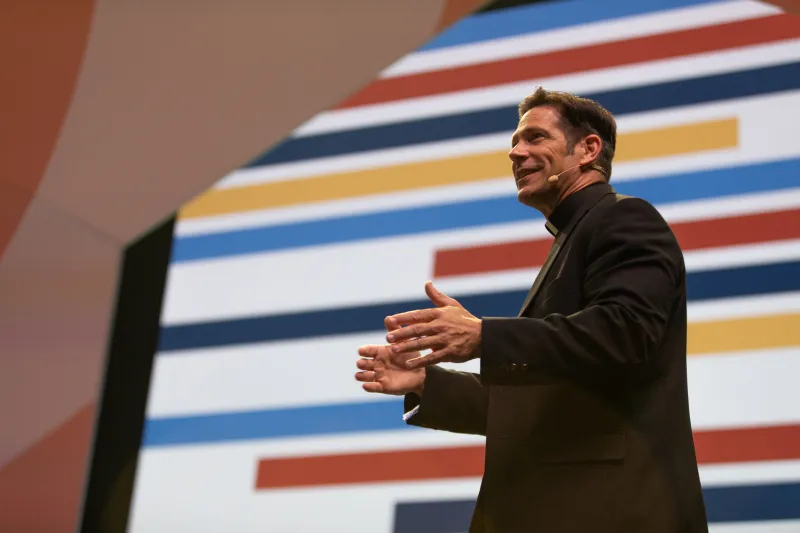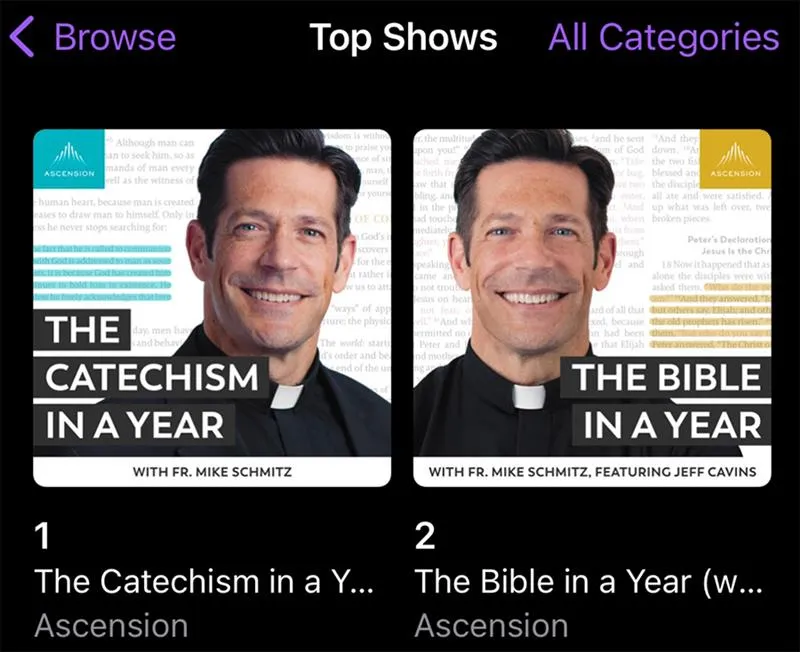
St. Louis, Mo., Jan 9, 2023 / 12:30 pm (CNA).
For the third year in a row, a Catholic podcast has bolted out of the gate after New Year’s Day to become the No. 1 most popular on Apple Podcasts, beating out secular podcasts from The New York Times, NBC News, and NPR.
But 2023 is slightly different from 2021 and 2022, for one key reason. This year, the top two spots on Apple Podcasts are currently held by Catholic podcasts — “The Catechism in a Year” and “The Bible in a Year,” both produced by Catholic publisher Ascension.
Father Mike Schmitz, a priest of the Diocese of Duluth, Minnesota, and host of both podcasts, told CNA last week that in the course of recording hundreds of episodes of the podcast, he has been struck by the “beautiful” composition of the Catechism of the Catholic Church, a hefty volume that serves as the definitive summary of the Church’s teaching.
Although the Catechism is specific to the Catholic Church, Schmitz said he believes anyone can listen to his podcast and learn from it. Schmitz said reading through the Catechism has served as a helpful reminder to him, personally, about many aspects of Church teaching.
“[Whereas] I might be very general with something, the Church wants us to be very, very clear,” Schmitz commented.
“And [the Catechism] articulates the faith, not only with clarity but also with beauty. So if I were to say anything that’s been a kind of surprise, it’s been not just the clarity, but the beauty.”

While some people might think of the Catechism merely as a resource, “like an encyclopedia,” Schmitz said, he hopes his podcast will help listeners to appreciate the Catechism as being permeated by “truth spoken in love.”
“[The Catechism] is not just a heady document. [It has] a beauty that speaks to the heart, not just to the head,” Schmitz said.
“The Catechism in a Year” is a sequel of sorts to the wildly popular “Bible in a Year” podcast, which began on Jan. 1, 2021. Instead of reading the Bible from cover to cover, that podcast followed “The Great Adventure Bible Timeline,” which was developed by Jeff Cavins. The timeline, centered on “14 critical narrative books” interspersed with the remaining non-narrative books, helps to maintain the story structure of salvation history.
Despite eventually relinquishing its No. 1 spot on the charts, “The Bible in a Year” has gone on to be downloaded some 430 million times.
“The Catechism in a Year” podcast follows a similar format to the “Bible in a Year” podcast in that there will be 365 daily episodes, with Schmitz adding his own short prayers and reflections. The United States Conference of Catholic Bishops had to give Ascension specific permission to distribute the Catechism in this format because it owns the copyright to the English translation for the distribution in the United States, Schmitz noted.
“No one’s been able to ever distribute the Catechism like this since it’s been promulgated in the ’90s,” he said.
Ascension president and CEO Jonathan Strate said the popularity of “The Catechism in a Year” speaks to a hunger among listeners to learn about God’s plan for their lives.
“To have a podcast about the Catechism of the Catholic Church reach No. 1 in the United States in all categories is an astonishing moment for the Catholic Church,” Strate said Jan. 3.
“It speaks to the deep longing we all have to respond to God’s plan for each one of us — a plan revealed so beautifully in the treasure that is the Catechism.”
Special bonus episodes of the podcast will feature Catholic leaders and experts Bishop Andrew Cozzens, Jeff Cavins, Mary Healy, and Sister Miriam James Heidland, Ascension said. Additionally, the Ascension edition of “The Catechism of the Catholic Church” has been released to accompany the podcast.
Schmitz said he considers the date of Pope Emeritus Benedict XVI’s death — Dec. 31, 2022 — to be significant since it was only a day before “The Catechism in a Year” podcast launched to the world. Benedict — then Cardinal Joseph Ratzinger — presided over the committee to create the Catechism of the Catholic Church, which was ultimately published in 1992.
If you value the news and views Catholic World Report provides, please consider donating to support our efforts. Your contribution will help us continue to make CWR available to all readers worldwide for free, without a subscription. Thank you for your generosity!
Click here for more information on donating to CWR. Click here to sign up for our newsletter.




Yes! The podcast is wonderful. I probably would never read the Catechism cover to cover but listening to Fr. Schmitz is a breeze. Thanks, Father and thanks, Pope Benedict.